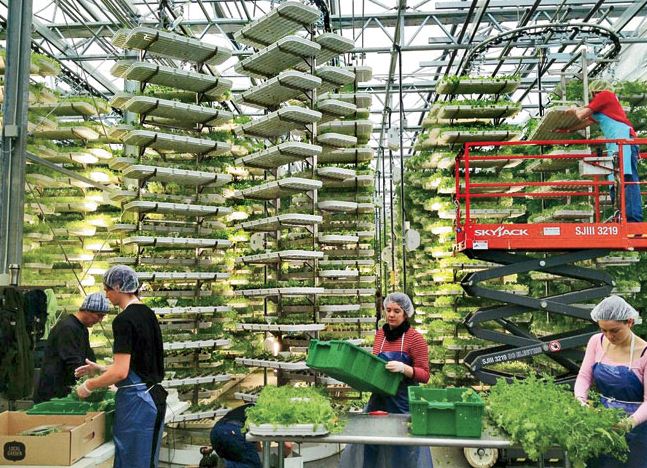Vertical Farming, continued
This is page 8 of our nine page series on hydroponic vertical farming. Click any of the below pages to jump to that page.
Page 1 Page 2 Page 3 Page 4 Page 5 Page 6 Page 7 Page 8 Page 9

Still another variation on the vertical farming theme. This installation combines vertical stacking with horizontally-moving trays. This arrangement allows for much of the work, and the much of the human access infrastructure, to be concentrated in one place. While vertical access is still a challenge, the infrastructure required for that access can all be located in one place. The tradeoff is that the moving racks themselves need maintenance. Photo courtesy of a Hudson Valley (NY) News Network article about vertical farming in the region.
Scalability
Can vertical farming be scaled up? The short answer is absolutely yes. The long answer is this: while systems can certainly be scaled up, the complexities they bring will increase even faster. The commercial ventures which failed, ran into unexpected problems when they built large vertical farming systems. We’ve already described the biggest issue: the higher those plants are stacked, the harder it is to tend them. Up to a certain height, roughly head-high, people can tend plants relatively easily. Beyond that, it gets much more difficult. Unfortunately, many of the advantages listed for vertical farming only occur when they’re stacked much higher than head-height, which is where things get complicated.
For those who very much want to try vertical farming, and/or compare vertical farming side-by-side with other hydroponic systems, my best suggestion would be to start small. Build a single vertical farming system, perhaps a single rack, and work with it awhile. You’ll certainly learn quite a bit about what works, and what doesn’t, with your particular system. When things don’t work the way you intended, and/or when you see ways to improve your systems, experiment. It’s only through experimentation that advances are made. When you’ve got a rack system that works the way you want, then you can start expanding. Expand slowly, because even two racks of the same configuration will change the dynamics of your infrastructure and workload. Then as things get comfortable, experiment again and expand again until you reach your goals.
My goal for this topic, and for this website in general, is to disseminate enough information to enough people that these various topics can be thoroughly explored, improved and then shared. If you have developed a vertical farming system which is easy to work with and can be scaled, Contact Us. We’d love to share your story!
Can Crops Be Germinated In This System?
Again, the short answer is yes, but with conditions. Since vertical farming can be composed of different hydroponic methods, conceivably one or more of those methods can be used to germinate young plants within a vertical farming system. For instance, young plants could potentially be seeded, sprouted and grown in flood-and-drain trays, and in some types of hydroponic buckets. Both of those approaches are already used in vertical farming systems. Yet NFT systems would not be a good choice for germination even though they are a common choice for vertical farming systems. The ultimate determinant will be whether the grower wants to set aside a certain portion of the vertical farming operation for germination purposes, or grow young plants in the same system as older plants. That is for each grower to decide.
Either option has proven cost-effective in come operations, but not in others. This variation is due to so many different details that it would be impossible to give a single yes/no answer here. My best suggestion is to consider this particular topic carefully before proceeding. Each crop will have different seeding, germination, and transplantation requirements. Additionally, each operation will have slightly different conditions which impact overall costs. Pencil out various germination options, experiment with those options, and see which approach yields the best overall results. Remember that while one approach might work better for the plants themselves, another approach may be more cost effective for the operation as a whole. Experiment with the most promising options, and try different variations. With time, the best option for your particular operation will make itself known.
Can Crops Be Transplanted Into This System?
In the case of transplantation versus germination, much of what we said above applies here as well. Some hydroponic approaches are very well suited for transplanting; NFT systems come immediately to mind. NFT systems almost universally depend upon transplantation. Plants can also be transplanted into flood and drain trays or bato buckets. The question here, as above, will depend upon a number of additional variables. The grower should work through several different options, first on paper and then in small scale experiments, to see which option works best in his or her particular situations. Remember to not only consider the technical aspects, ie the number of crops which can be transplanted into any given approach, but also the human labor required to do the work. It’s human labor which will typically be the determining detail for which approach is the most cost-effective.
BACK NEXT
This is page 8 of our nine page series on hydroponic vertical farming. Click any of the below pages to jump to that page.
Page 1 Page 2 Page 3 Page 4 Page 5 Page 6 Page 7 Page 8 Page 9